It is very flexible in terms of set up options. The RS20i includes the full version of Dirac Live room correction which is among the best room correction packages on the market. This is the best sounding surround processor I have reviewed to date.
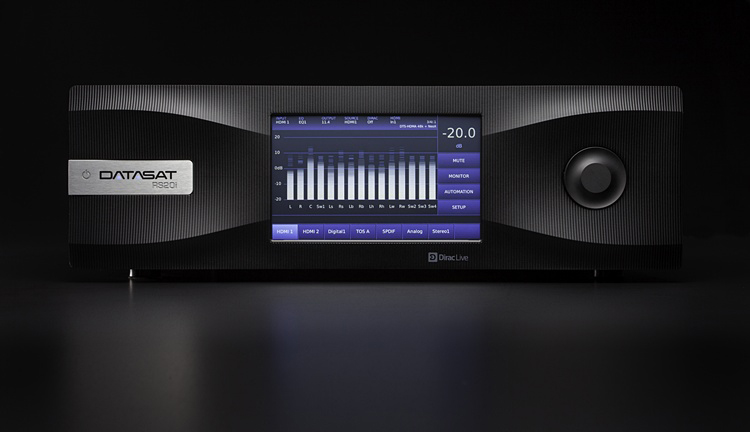
Datasat RS20i Surround Sound Processor
- Includes all the latest surround formats
- Superior product design
- Rock-solid audio performance
- Extreme flexibility – grows with system, upgradeable
- Direct, RF, Network or Serial Control only (no IR Remote)
- Logical but complex user interface
Datasat was part of DTS® (Digital Theater Systems) from its inception in 1991 up until they spun off as the cinema branch in 2008. This means that Datasat was there with DTS as they developed their audio codecs. And they were part of the team that helped expand their technology to over 30,000 commercial cinemas worldwide.
Processing:
Design:
16 Channel Preamp/Processor
DACS:
Burr-Brown PCM 4104
DSP:
Analog Devices SHARC (x 9!)
Dirac Live:
Room Correction
EQ:
31 Third-octave Bands plus 3 Full Parametric Bands per Channel, Shelving, High and Low Pass
Dolby and DTS Surround Sound Processing:
DTS:X ready, Auro (13.1) and Dolby Atmos
Video Upconversion:
None (pass-through only)
Connections:
HDMI 2.0:
4 In and 1 Out
Digital Audio Inputs:
2 x DB25 Female (8 channels each), 2 x Toslink, 1 x Coaxial
Analog Audio Inputs:
8 Balanced via Female DB25, 2 x Stereo Single Ended via RCA
Microphone Input:
With Phantom Power for Spectrum Analyzer Function
Digital audio out:
16 Channels Via 2 Male Db25
Analog Audio Out:
16 Channels via 2 Male DB25
Front-panel USB input:
Firmware Updates
Rear Panel USB input:
Music Playback
Ethernet and RS 232:
For Network and Control Functions
Triggers:
Fully Programmable
General Features:
3D:
Video Pass-through
Control:
System Compatibility
VPN Control Via PC:
Mac and Android
Dimensions:
5.6” H x 17.4” W x 17.63” D
Shipping Weight:
36 Pounds
MSRP:
$ 23,170
Company:
SECRETS Tags:
Datasat, Datasat RS20i, Surround Sound, Surround Sound Processor, Processor Reviews
This means that cut their teeth mastering movie soundtracks and building commercial cinema systems. They even won an Oscar in 1996 for scientific achievement!
The Datasat RS20i is a commercial piece at heart. It has been scaled down slightly for domestic use. It’s still a large component but with a clean, modern look. The RS20i’s case is full of high end components. Plus it has the full version of Dirac Live room correction and can handle up to 16 channels. I’ll be putting it through its paces below to see how it stacks up.
This may be the most outrageous home theater product I have ever reviewed. Don’t get me wrong as I mean this in the nicest way possible.
Please allow me to explain: The RS20i is not an inexpensive product, but it is well worth the cost in my opinion.
I have reviewed my share of other high end products before. Some of these products I would classify as overpriced. That’s because they weren’t very innovative or particularly great sounding. They were just expensive mostly because of the name on the faceplate or due to some other perceived value.
Other high end products may have been over designed. The price may have been fair for what was provided but they could be viewed as sloppily designed and inefficient in this regard. Perhaps the design engineer was just throwing expensive components at the problem.

The Datasat RS20i represents a different kind of high end product – the kind where the price is reflective of the quality of the product and especially its performance. The RS20i’s case really is packed with more technology than anything I have had in my system before. But I do not view the RS20i as over-designed. Instead, I see it as “appropriately designed”. That is to say that the Datasat engineers tackled each design decision, each and every part of the circuit with the best circuit design and componentry they could apply at the time.
That’s one reason why the RS20i has 9 DSP chips. You need that many for all the channels but also to maintain pristine and full range sound with the large amount of processing that is going on.
The volume controls are all analog. This is a difficult and costly approach. The volume control is handled this way primarily so you don’t lose bit depth which happens when you have a digital volume control. Lost bit depth reduces the S/N ratio. Very few multi channel products use all analog volume controls and I know of no others that do this with 16 available channels like the Datasat.
The RS20i also has full Dirac Live room optimization/correction built in. Dirac Live is a high end room correction system that not only corrects for proper frequency balance but also manages to correct certain impulse response anomalies. Dirac is typically limited to no more than 8 channels, but the version in the RS20i is a unique version of the system that is made exclusively for Datasat. Not only can this version handle up to 16 channels (24 with the expansion card), but it allows the calibrator to set the crossovers before running the correction routine.
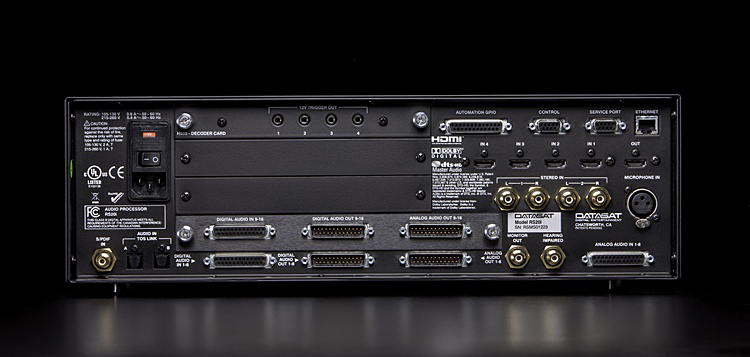
Like many of the other room correction systems on the market, Dirac Live samples the response in numerous seating locations and attempts to optimize the results throughout the room’s seating areas. Measurements are typically taken at nine different positions for this purpose but you could measure more locations in a big theater.
Another excellent feature with Dirac Live is that the calibrator can tune the system to custom target curves. This isn’t normally done to create a unique or “voiced” sound but can be used by the calibrator to tailor the correction more closely to a difficult room. I will talk more about this in the Set Up section of this review, but the basic idea is that you can’t realistically overcome every anomaly in a room while simultaneously ensuring reliable performance of your components by not overdriving your speakers or your amps.
The RS20i allows an unprecedented degree of control beyond that by including a 31-band third-octave graphic EQ along with a three-band parametric EQ on each channel. These EQ’s are “stackable” meaning that they can be applied simultaneously and I used them to effectively tweak the performance in my room.
This unit can also accommodate up to 4 discrete subwoofers, each with their own equalization, delay and impulse correction.
There are 20 memory slots to store settings for various sources, types of material or just for those users who enjoy playing around with the system’s settings and saving their work to be called up on demand. I would never need this many slots myself, but I could see having a few different ones to use for movies, classic movies (with re-eq), music, gaming, stereo and maybe mono sources.
The RS20i is a modular design that can be updated through expansion slots or through replacement of some of the core modules in the case. This is most useful to add new features. One such option is that the HDMI card is an expansion slot and plans are in the works to offer an upgrade card that can handle 4K video with wide color gamuts. The RS20i is also ready for the latest upgrades to include the new audio formats such as Dolby Atmos and DTS:X. I will be getting the Atmos expansion card soon and will do a future update to this review in regards to this enhanced capability.
Let me run through a few more of the incredible things about the RS20i that are further evidence of its superior engineering and that really set it apart from the competition:
- The all-analog volume controls are balanced and not single-ended.
- The RS20i can process all 16 channels while maintaining a sampling frequency of 96 kHz at all times.
- The sample rate continues at 96 kHz even with Dirac Live and the other EQ’s engaged.
- It is now Dolby Atmos and DTS:X ready.
- DAC section uses fully balanced OPA 1632 op-amps.
The RS20i is a commercial product at heart. One example of this is that it uses DB 25 breakout cables for many of its digital inputs and outputs as well as all of its multi channel analog inputs and outputs. Hook ups in this case are by way of break out cables that are supplied with the unit when purchased. These connections are typical for professional mixer boards and similar applications.
In terms of the RS20i, this allows for the massive number of connection possibilities while maintaining the product at a domestically useful form factor (i.e., not too large). In other words, if you tried to have all these connections on a single chassis, the back panel would be humungous. The DB 25 connections allow this high degree of connectivity in a reasonably sized product.

All analog connections over the DB 25 connectors are balanced connections. You can use simple, inexpensive adapters to convert from the provided balanced XLR’s to unbalanced RCA’s which is what I did for some of my older sources but this is not actually necessary as Datasat has available breakout cables with unbalanced RCA’s as well.
This product is designed primarily for use in a high end dedicated theater. One reason I say this is that it lacks an IR remote control interface. Most buyers of the RS20i have advanced control systems in their theaters so the idea of excluding the IR remote does not impact Datasat’s typical customers in any meaningful way.
As mentioned previously, the RS20i has Dirac Live room correction built-in. This is indeed a luxury product and most buyers of an RS20i will have their dealers install and calibrate their systems. In my case, an engineer from Datasat flew in and set up the unit in my theater. This gentleman impressed me greatly with his knowledge of the product, his background in the industry and his ability to quickly calibrate the system to a high level of performance.
The first thing we did was get the product installed in my equipment rack. We connected the sources, amps, and my front projector to begin with. (An aside, the RS20i has but one HDMI output. This meant I had to switch out cables every time I wanted to change from the flat panel to the front projector. I would have used my old HDMI splitter, only I gave it away a few years ago. So I just manually switched out the cables when necessary.)
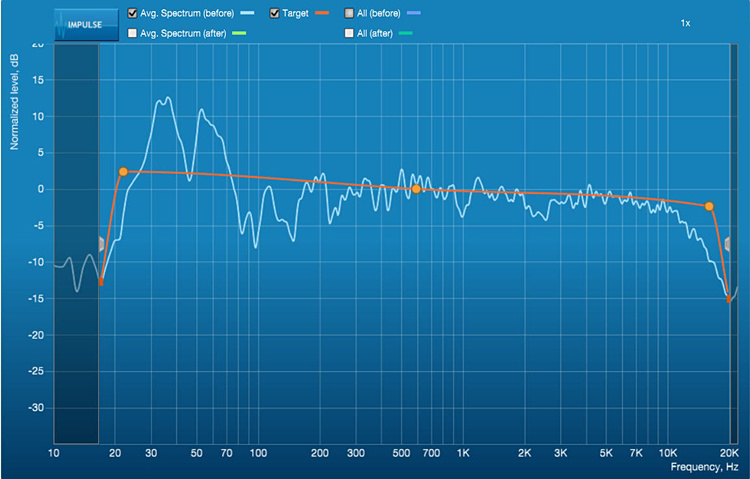
Once we got it all hooked up, it was time to calibrate the audio via Dirac Live. Take a look at the before image we obtained prior to calibration. This is the main left channel frequency response. I used to have a great sounding room and then we remodeled with new carpeting, new furniture, new window coverings and by refinishing the fireplace. Now I have this massive peak in the low bass. At least the response above about 250 Hz is still excellent.
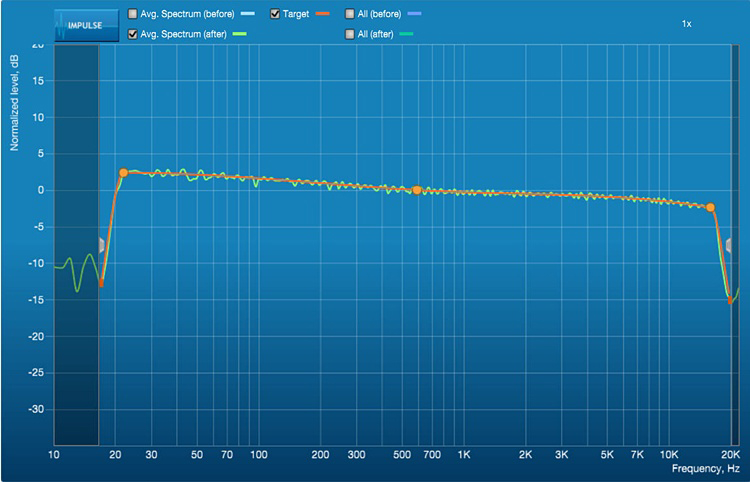
Now take a look at the after response. Looks good, right? Well not so fast. One concern I have with the default Dirac target curve is that it tries to do too much. What I mean by this is that it tries to do things with the response that aren’t always possible or desired.
One example is that the processor is trying to fill suckouts at 48 Hz and 80 Hz. This is not a good idea as it may potentially overload the subwoofer and/or amplifier. Also, Dirac wants to push my tweeters to be more or less flat out to beyond their native response. I view this as less of a concern because there isn’t much material above 10 – 12 kHz on most soundtracks but it still bothers me that the tweeter could be over driven in this way.
The full Dirac Live version that is included with the RS20i allows the calibrator to adjust the target curve and we would have used this functionality to tweak the target curve in my system. The only problem was, I didn’t have enough time that day for this to happen. Well, lucky for me, I have the ability to run my own test curves and then I used the RS20i’s “stackable” EQ’s to allow the suckout continue somewhat, to let the low bass increase a little bit above flat due to room reinforcement and also to let the tweeters roll off naturally.
It is super cool that you have this kind of flexibility with the RS20i. But also, if you don’t have the testing equipment and skills that I have, you could still accomplish the same things by sending your own target curve to Datasat. They can use your custom target to update the correction remotely, email you back the revised data file and then you can load it into the RS20i memory. This new curve could then be saved in one of the 20 available memory slots. And let me tell you that the good folks at Datasat are quick responders to every request I made – about as quick and precise of any company I have worked with.
A couple of additional points – I do not have a control system in my theater so I connected the RS20i to my home network (via a wireless bridge) and then controlled it using an HTC One phone via a VPN app. The RS20i can be controlled this way but not wirelessly, it needs to be hard wired to your home network (or you might use a wireless bridge as I did).

Lastly, the Datasat RS20i has a large and very useful color touch screen display which is emulated on the VPN app. Whether I used the front panel or the app, I had complete control of the product. I found the organization of the menus to be very logical and the degree of control you have is the most flexible I have ever seen in a consumer product.
We are in the midst of a new golden age of movies. This goes for movies of all kinds, but especially in terms of movies with significant special effects. The ongoing improvements in film-making technology mean that we have a huge number of movies these days that really let you get away from it all better than ever. I love being able to spend a few hours living a fantasy – it’s good for my psyche!
The incredible performance of the Datasat RS20i facilitated my decadence and during the time I had the RS20i in my system, I enjoyed a skein of great movie releases unlike anything I can recall. Like I said, movies are improving all the time and the RS20i was able to wring out the best in every movie I watched.
This made the RS20i a movie (and Blu-ray) watching machine of the highest caliber. Sure I listened to music through the RS20i, but that was only during short interludes while waiting to fire up the next movie. Day in and day out, the RS20i provided me more overall satisfaction through its performance than any other product I have ever had in my system.
I was able to really kick back and enjoy the material without obsessing about the sound quality. Everything I played through the RS20i simply sounded “right”. You may know what I mean if you have been at this for a time. Even great products may sound thin one day, lush the next, constantly begging for you to tweak the channel levels or make other adjustments. Not the Datasat RS20i. Once it was set up and dialed in, this bad boy simply sounded “right” every time I fired it up. And it was head and shoulders better sounding than any other surround processor I have had in my system.
One thing that stood out was how the sound held up at all volume settings. I’m especially talking about low levels. I think this must be due to the analog volume controls in concert with the low noise floor and low distortion. Any time I came home from the office and fired up the nightly news, I would find myself listening sometimes at the lowest volume settings I have used in a long time. I didn’t think about it much until those times when I would suddenly realize the volume was really low. But I could still hear everything – the voices, the music, the environmental sounds, etc. The low volume clarity was incredible. This ability to sound great at very low volumes was in my view a very telling sign of the amazing quality of the circuit design and execution inherent to the RS20i.

Then there were all the great movies I auditioned. These were mostly Blu-ray discs and I felt quite fortunate to have the Datasat RS20i in the system during a time when there were so many exciting films to enjoy. I’m talking about movies such as Interstellar, Insurgent, Jurassic World, Avengers Age of Ultron, San Andreas and Furious 7 to name a few.
Each one of these movies offered me the opportunity to take a little sojourn from reality and it was the RS20i that made this happen better than any other processor I have reviewed to date.
Secrets Sponsor
One specific example stems from me attending CEDIA Expo in Dallas during the review period. I was a little surprised that more than 90% of the movie demos I saw at the show included a clip or two from Mad Max Fury Road. But maybe I shouldn’t be too surprised by this as it is a great movie, an excellent piece to demo a system and it was one of the few discs that had a Dolby Atmos mix to evaluate.

So I wound up seeing and hearing Mad Max many times on some truly excellent systems. By the end of the show, I felt that I really knew what this movie should sound like. And it was the first movie I watched on my system after getting home from CEDIA. This movie sounded better over my system than any of the times I heard it at CEDIA Expo. I’m chalking that up to the Datasat RS20i.
All the bombastic moments were even more epic than ever. From the war drums, to the massive guitar sounds all the way through to the growling engines, this was definitely something very special. Certainly, the bass was strong and clean. The treble was likewise extended, but the part of it all that stood out for me was the ability of the Datasat to sort all the sounds in the most complex parts and then throttle back when necessary to let the subtler sounds flow uninhibited during the quiet scenes. I was literally blown away by what I heard. The RS20i was the shining star of my system!
Secrets Sponsor
So now I’ve mentioned the greatness of movies in general and I’ve mentioned some specific movies I enjoyed recently but there was one movie that brought it all together during the Datasat RS20i review. Laugh all you want, but the movie that rounded out all my positive impressions was Spy.
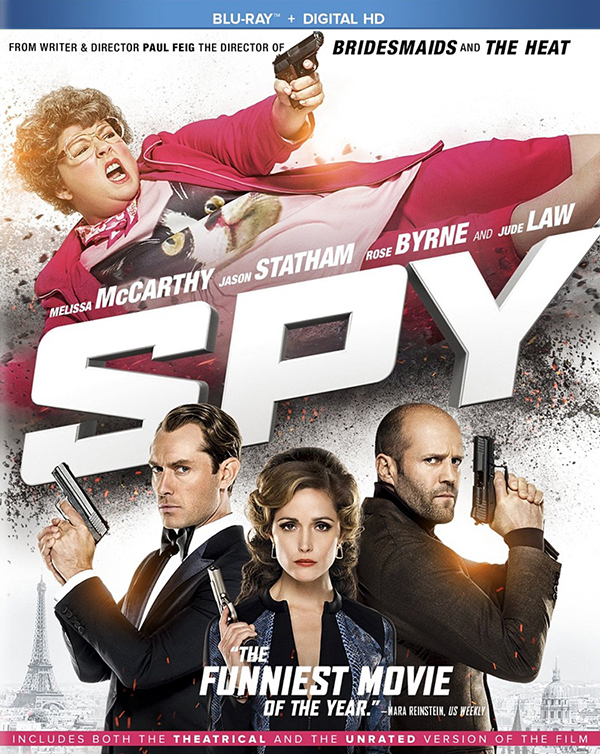
Yes, I am talking about the comedy with Melissa McCarthy in the lead role. I watched this near the end of the evaluation period. It struck me as something where I could hear all the positive qualities of the Datasat RS20i. So like many of the other movies I mentioned above, Spy had excellent action sequences that were immersive with exceptional transients and strong bass response.
But the reason I say that it brought everything together is because this movie kinda sorta had it all. The placement of discrete sound effects was spot on. And I was taken aback by the musical soundtrack by Theodore Shapiro. This movie really did have it all and the Datasat RS20i let it shine.
The Datasat RS20i had the best bench test results I have ever gotten when testing a surround sound processor or receiver. This is a testament to the excellent engineering and substantial execution inherent in the product.
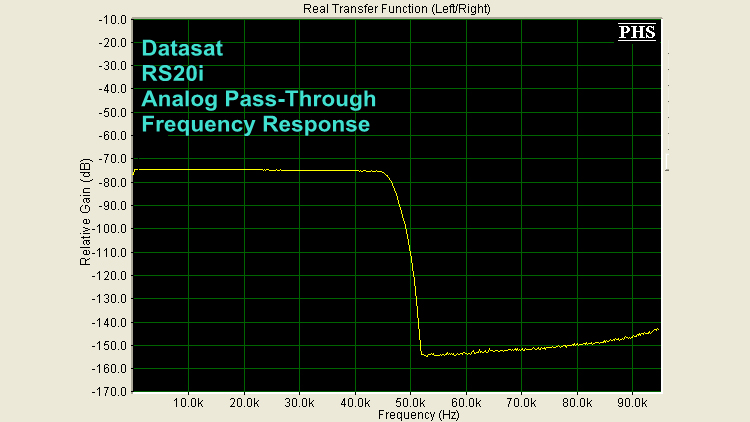
The above plot is the analog frequency response taken from the left channel in to the left channel out. All processing was turned off. The response was very flat from infrasonic to nearly 46 kHz, at which point the filters kicked in.

This plot shows a 1 kHz test signal at 2 volts. The THD+N was incredibly low at 0.0006%.
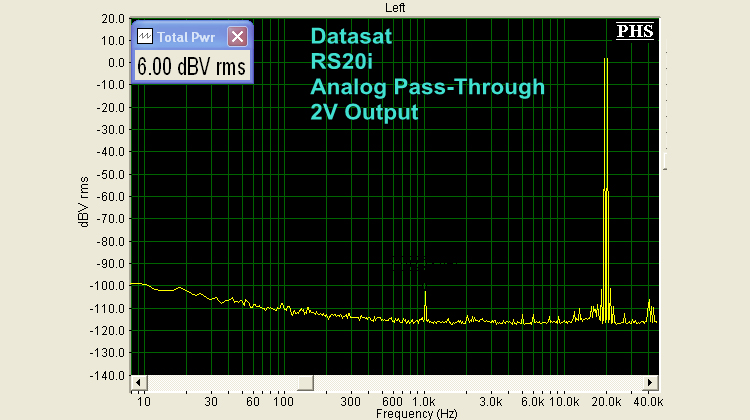
This is an intermodulation distortion (IMD) test with simultaneous 19 kHz and 20 kHz test signals at 2V output. Also tested on the analog inputs, the sympathetic tone at 1 kHz is reported as the B to A peak, and it was 102 dB below the test signals.
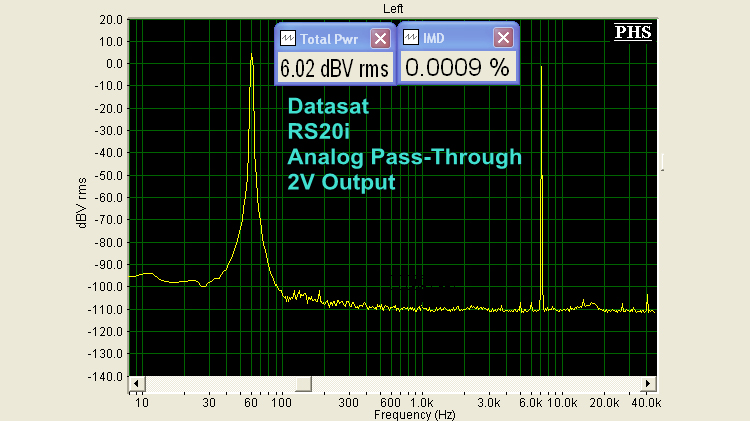
Here is another IMD test with 60 Hz and 7 kHz test signals. Over the analog inputs, the IMD distortion measured just 0.0009% at 2V output.
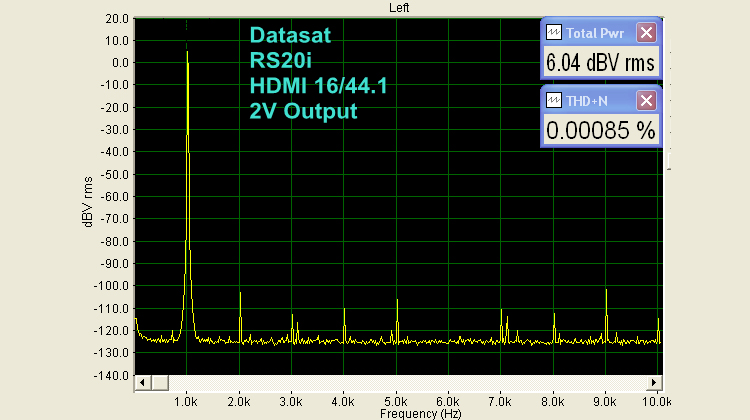
Now we see a 1 kHz sine wave test via the HDMI inputs at a sampling rate of 16 bit and 44.1 kHz. The THD+N at 2V out was just 0.00085%.
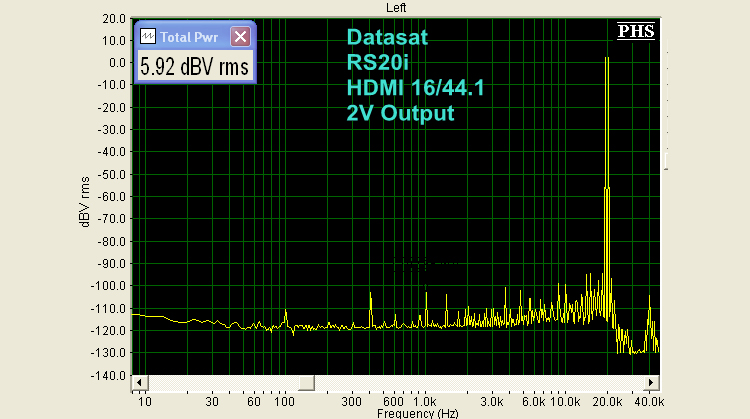
With 19 kHz and 20 kHz digital test signals at 16/44.1, the B-A peak was 102 dB below the test signals.
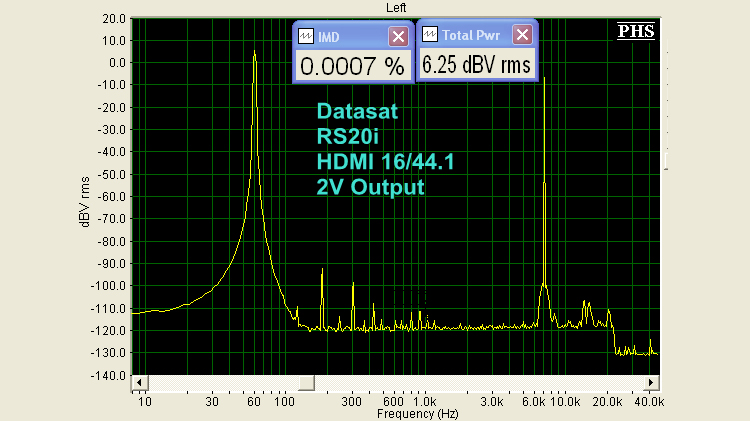
Under the same testing parameters, the IMD tested at just 0.0007%.
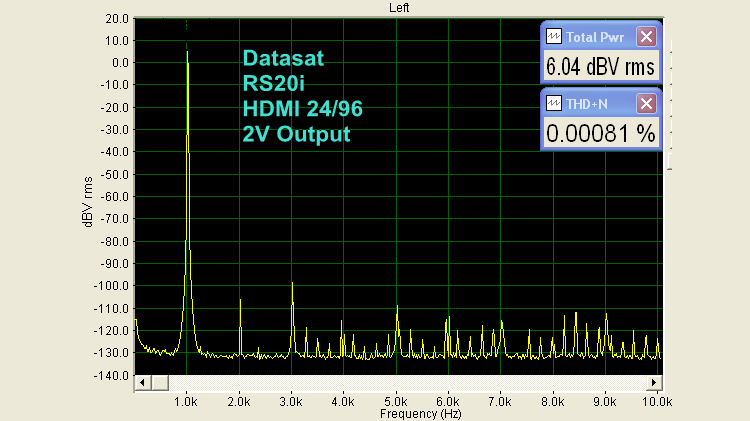
Again through the HDMI input, the THD + N at 1 kHz and 2V out was just 0.00081%. The signal in this case was a 24-bit 96 kHz test signal.

In this 19 kHz, 20 kHz test, the B-A peak at 1 kHz was minus 105 dB below the test signal.
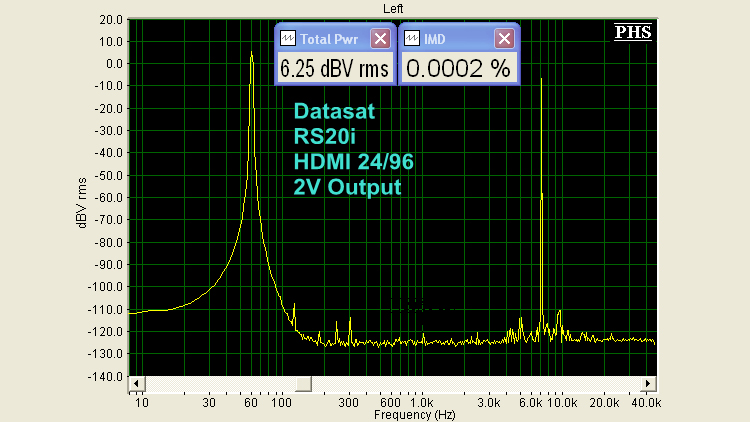
Finally, the IMD test at 24/96 and 2V is 0.0002%!

THE DATASAT RS20I is Quite an Accomplishment.
- Excellent measured performance
- Upgradeable
- Flexible interface
- Top tier room correction
- Pristine and reliable audio performance
- Dual HDMI outputs
- RF Remote capability
The Datasat RS20i is quite an accomplishment as far as I am concerned. The engineering and manufacturing behind this amazing product are of a very high caliber. It comes ready for up to 16 discrete channels and can be easily expanded to 24 channels. It has a modular architecture and can be upgraded for most every new audio or video format that comes along. This makes it about as future-proof as any other product on the planet.
It is equally at home in a moderate system as it is in a super high end custom dedicated theater. And I have come to find out that the Datasat RS20i is apparently the top choice among Hollywood A-List stars when outfitting their personal screening rooms.
But what it all comes down to is the actual performance. Well the RS20i just so happens to have the best bench test results I have ever gotten from a surround processor or receiver. So you know the RS20i gives you great measured performance. And this equates to the best subjective performance I have ever enjoyed. I did not hear one single thing out of the RS20i that I would characterize as a flaw. Quite the contrary, everything I heard from this product was simply correct-sounding and so clean and pure of tone that it was actually hard to believe.
The only negatives I have would be some of the quirky design decisions like no IR remote and the use of DB 25 breakout cables. But to me these ultimately contributed to the endearing nature of this product that just marches brilliantly to the beat of a different drummer.
My final opinion is that I now hold the Datasat RS20i at the pinnacle of surround processors. It will stay there until something else come along and knocks it off its perch. I’ll let you know when that happens, but for now the Datasat RS20i is the best surround processor I have ever heard. Period. Case closed.


